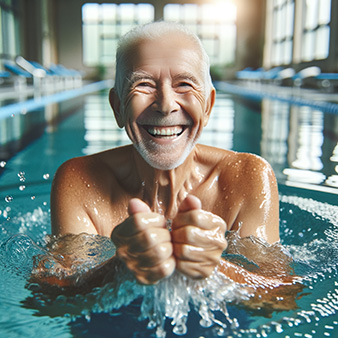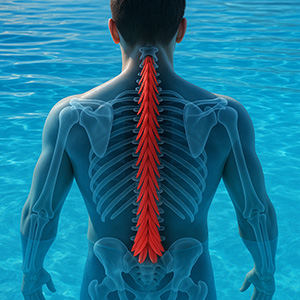Feeling Like Your Back’s Unraveling? Meet the Multifidus
If you’ve ever suffered from low back pain, you’re not alone—and you may not realize there’s a small but mighty muscle playing a huge role behind the scenes: the multifidus. This deep spinal stabilizer runs along your vertebrae, firing up just before you move to keep your spine aligned, supported, and happy. When the multifidus weakens or gets “shut off” by pain or injury, your back loses its stabilizing crew—and trouble begins.
Multifidus dysfunction often leads to micro-instability, irritation, and even chronic pain—the sort that lingers despite the best stretches, massages, or ergonomic chairs. Over time, these deep muscles shrink (atrophy), get replaced by fat, and let the bigger, surface muscles take over. But here’s the irony: the big muscles are built for movement, not micromanagement—meaning they do a sloppy job supporting each vertebra, which can amplify your pain.
Why Water Makes a Splash in Spinal Rehab
Aquatic exercise isn’t just about gentle movement or “old school” rehab. It’s a science-backed powerhouse for reactivating the multifidus and restoring true spinal stability. Here’s why the pool is your back’s best friend:
Buoyancy means less load: Chest-deep in water, your spine bears up to 70% less weight—the perfect setup for pain-free practice.
Constant micro-resistance: Water’s 360° resistance gently forces your multifidus and core to work—every movement, even the smallest adjustment, becomes an opportunity for spinal muscles to fire.
Reduced pain, better results: Studies show aquatic exercise matches or exceeds multifidus activation seen on land—with participants reporting much less pain and higher confidence.
EMG studies support that when you hold a plank, perform bird-dogs, or balance on one leg in the pool, your multifidus “wakes up” and gets stronger. Over 6–12 weeks, these changes are visible under ultrasound, with increased muscle size and strength—and, best of all, less back pain.
Top Aquatic Moves for Multifidus Strength:
River Planks: Hold a plank on a submerged step; resisting water currents trains deep spinal muscles.
Aqua Bird-Dogs: In all-fours position, slowly raise opposite arm and leg; add a float or paddle for a dynamic challenge.
Single-Leg Balance: Stand on one foot, using the water’s resistance to challenge and activate stabilizers.
Could Aquatic Rehab Help You Avoid Spinal Cord Stimulation?
For some, chronic back pain gets bad enough to consider advanced treatments—like Spinal Cord Stimulation (SCS), which uses implanted devices to mask pain signals. But not everyone wants surgery or hardware. The good news: consistent aquatic therapy can offer dramatic improvements for many patients, sometimes making invasive options unnecessary.
Research from leaders like Dr. Vinny Francio and major pain centers highlights this “prehab” approach: many patients trial aquatic therapy and report 30–50% pain reduction in a month—with improved sleep, less stiffness, and better movement. This not only buys time to avoid or delay SCS, but ensures that if a device is needed, the patient is stronger and recovers faster.
Aquatic Benefits Ripple to Hips and Knees
Don’t stop at the back—the pool works wonders for the whole body. Pelvic and knee pain often stem from similar issues: weak deep stabilizers (like the popliteus at the knee or hip rotators). Water exercises such as lunges, step-overs, and resisted side-walks activate these underappreciated muscles, improving balance and reducing the risk of falls or joint injury.
For those with osteoarthritis or joint replacements, aquatic workouts mean:
More reps with less pain: Water reduces impact, letting you move longer for better strength gains.
Sharper proprioception: The resistance boosts your joint’s “GPS,” improving control and confidence.
Faster recovery after surgery or flare-ups: Regular aquatic sessions ease swelling and get muscles firing safely.
Beyond the Muscles—Why Water Eases Pain and Lifts Spirits
Science supports what every aquatic therapist knows: the pool is magic for pain relief, not just because of movement, but because of how water interacts with your body and brain:
Skin-level stimulation will “gate” pain signals, meaning warm water and gentle pressure overwhelm your nerves so pain can’t get through as easily.
Natural endorphin release, leaving you with a “pool after-glow” that lasts for hours.
Less guarding, more freedom: Buoyancy means less fear of movement, turning off those painful spasms that clamp down around your spine.
Patients consistently report better mood, easier transitions, and a window of relief after each pool session. For those tired of being sidelined by pain, the pool offers not just physical therapy—but renewed confidence and hope.
Your Takeaway: Don’t Wait for Surgery—Make Waves
If you or your clients are struggling with stubborn back, hip, or knee pain, consider an aquatic regimen focused on reactivating your multifidus and deep stabilizers. Not only is it gentle and accessible, but it’s also scientifically proven—and might be the key to bypassing more invasive treatments.
Want a place to start? Ability Fix is here with tailored aquatic workouts for all levels. Our habit-based plans and easy-to-follow routines can transform your core strength, support your joints, and help you move through life pain-free.
Ready to reclaim your back (and your future)? Jump in—the water’s fine!










